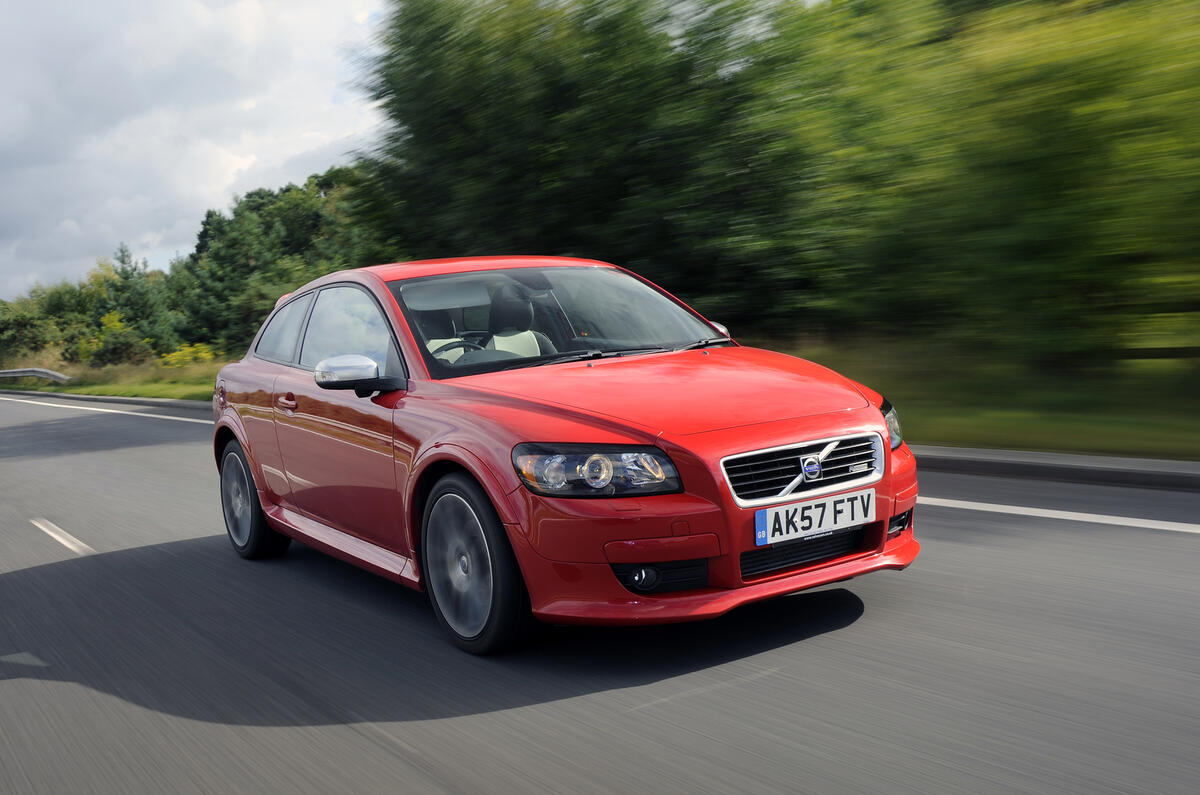“I should try the 1.6 diesel if I were you.” The words were the Volvo PR man’s, and were slightly disappointing to hear given that this was seemingly the least exciting version in the C30 range.
But the truth was already out, and our pragmatic PR knew it. He’d driven them all, and the 1.6D had the best chassis, because it had the most pliant suspension. What was the truth? That despite borrowing heavily from the parts inventory of the best small family hatchback on the planet, this Volvo was very far from being the world’s best small four-seater coupé.
It was baffling, really. Volvo was part of the Ford empire at the time, specifically the Premier Automotive Group if you remember that (Aston Martin, Jaguar, Land Rover, Lincoln and Volvo were its components, from 1999 to its final 2010 dismembering) and it was able to use the Ford Focus as the basis for this small and classy coupé. Which meant that, potentially, it could build on the best small hatchback chassis in the business and a decent array of engines. But only potentially.
The wasting of some of this potential would only emerge when the wrong kinds of bump and bend spoiled Volvo’s day. Before that, we could all get excited about the C30’s slightly offbeat design, a tailgate entirely of glass, a long, tapering roof, high-stacked taillights, a wedge of side windows and a neatly thrusting nose among the highlights. True, to the uninitiated it looked much the same as a three-door hatchback, but if its pertly distinctive rear end and wheel-arch extensions didn’t disabuse you of that notion, the roundly unhelpful tailgate opening, small boot and limited rear head room certainly would. All of these drawbacks are typical of coupés, of course – these are the sacrifices that must usually be made for that style.
The C30 was following a lineage of small, practical Volvo coupés stretching back to the P1800 ES, a shooting brake version of the pretty P1800 coupé. That had four slightly confined seats and a frameless glass tailgate, as did the 1987 480ES, which the C30 replaced after an 11-year pause. It was keenly anticipated, Volvo first hinting at the C30 with the 2001 SCC concept in 2001. A year later, Volvo committed to a production version, although it took six years to emerge. By that time, the keen – in the UK, at least – wanted the C30 now. And that meant Right Now. But many were thwarted by supply problems, losing the C30 that vital early sales momentum.
Despite this, Volvo’s smallest just outsold the 480 ES over its seven-year life, finding well over 22,000 UK buyers. Apart from its subtly distinctive styling, C30 buyers also got an interior of unusually clean sculpture, the smooth escarpment of the upper dash a contrast to an aluminium centre console thin enough for stuff to be stored behind it. You could add excitement to your journey, possibly dangerous, as you furtled under the dash trying to find something you thought you might have left there but couldn’t quite see. Storage apart, the C30’s cabin was a very rational, finely finished space that was just a little dull unless you ordered the optional orange upholstery, this hue also available for the exterior.





Join the debate
Add your comment
I had a 2.5 5 cylinder auto SE Lux in blue with cream leather interior bought new in 2008. Great looking car BUT with a terrible ride, and as I used it for short local journeys terrible fuel economy.
Equally unfortunately the quality was lacking in places. The chrome on the smart looking chrome alloy wheels would start to flake off, as would the surface of the leather upholstery on the drivers seat. Also, and thanks to my OCD, the aluminium finished centre console was too delicate, easily showing up unsightly dents, resulting in many replacements being fitted!
However, if you wanted a smallish distinctive looking hatchback with auto box, there was nothing else that competed...
I wanted a C30 back in 2002, I thought they were achingly, delicately gorgeous at the back, though the front end was utterly bland and any-old-small-hatchback anodyne by contrast.
I went and had a look, I persuaded myself that that gorgeous rear window glass would be fine to get my bike into the hatchback, even though I knew it really wouldn't be and I'd scratch-up the interior).
Then I had a testdrive in a 2.0 petrol and it all went wrong. It just didn't handle. It wasn't that it completely lacked grip exactly, but it just understeered so much, I'd turn into the corner and turn the wheel then have to turn it more and could feel the front just washing out. Completely predictable, but I could just see me wearing out front tyres at a hell of a rate.
I really wanted a diesel, cos back then they were the wonder things, low nitrous emissions and huge mpg, save the planet and save money. They didn't have a diesel C30 but I could drive a diesel S40 - it was awful, even worse, plenty quick enough but just pushed straight on in corners.
So I said no, hummed and haa'd - and bought an Impreza WRX instead !
Come 2009 and changed roles, would be doing more miles and getting a company car allowance, so got a Scirocco, very much a parallel car to the C30, a sporty/pretty coupe/hatchback based on the everyday hatch - and yes, even though the Scirocco had a bigger tailgate than the Volvo's glass, I did scratch-up the edges with my bike, which had just chucked into the Impreza wagon so easily !